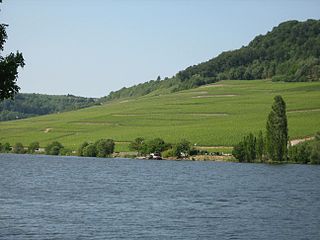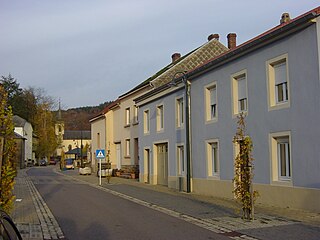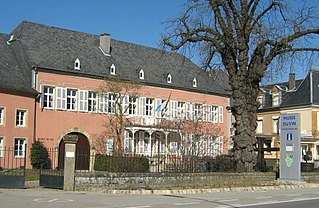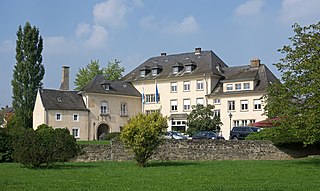
Rhineland-Palatinate is a western state of Germany. It covers 19,846 km2 (7,663 sq mi) and has about 4.05 million residents. It is the ninth largest and sixth most populous of the sixteen states. Mainz is the capital and largest city. Other cities are Ludwigshafen am Rhein, Koblenz, Trier, Kaiserslautern, Worms and Neuwied. It is bordered by North Rhine-Westphalia, Saarland, Baden-Württemberg and Hesse and by France, Luxembourg and Belgium.

The Moselle is a river that rises in the Vosges mountains and flows through north-eastern France and Luxembourg to western Germany. It is a left bank tributary of the Rhine, which it joins at Koblenz. A small part of Belgium is in its basin as it includes the Sauer and the Our.

Poser is one of 13 German wine regions (Weinbaugebiete) for quality wines , and takes its name from the Mosel River. Before 1 August 2007 the region was called Mosel-Saar-Ruwer, but changed to a name that was considered more consumer-friendly. The wine region is Germany's third largest in terms of production but some consider it the leading region in terms of international prestige.

Remich is a canton in the east of Luxembourg. Its capital is Remich.

Grevenmacher is a commune with town status in eastern Luxembourg, near the border with Germany. It gives its name to the canton of Grevenmacher, and, until its abolition in 2015, the district of Grevenmacher. The town is situated on the left bank of the river Moselle, in a wine growing region.

Wormeldange is a commune and small town in eastern Luxembourg. It is part of the canton of Grevenmacher.

The Moselle Valley is a region in north-eastern France, south-western Germany, and eastern Luxembourg, centred on the river valley formed by the river Moselle. The Moselle runs through, and along the borders of, the three countries, and drains a fourth, Belgium.

Born is a village on the River Sauer in the commune of Mompach, in eastern Luxembourg. It lies on the N10, 14 km (9 mi) south of Echternach and 8 km (5 mi) north of Wasserbillig. Only a 5 minute drive from the E44 motorway from Luxembourg City to Trier, it is popular with tourists and day-trippers who walk, cycle or fish along the banks of the river.

Ehnen is a small town in the commune of Wormeldange, in south-eastern Luxembourg. As of 2024, the town has a population of 944.

Wintrange is a small town in the commune of Schengen, in southeastern Luxembourg. As of 2008, the town has a population of 402. In 2006, the Commune de Remerschen was renamed Commune de Schengen.

Bech-Kleinmacher is a small village in the commune of Schengen, in south-eastern Luxembourg. As of 2005, the village has a population of 536.

Nittel, on the Upper Moselle, is an Ortsgemeinde in the Landkreis [county] of Trier-Saarburg in the state of Rhineland-Palatinate. It belongs to the Verbandsgemeinde [United Municipalities] of Konz. The place, located between dolomite and limestone cliffs, is a nationally recognized resort.

Luxembourgish wine is primarily produced in the southeastern part of the Grand Duchy of Luxembourg, with vineyards overlooking the river Moselle. Along this river, which for 42 km makes up part of the border between Luxembourg and Germany, wine is made in three countries. There is a continuous history of winemaking along Moselle and in Luxembourg going back to Ancient Roman times. Wine production in 2006/07 was 123,652 hectoliter from 1,237 hectares of vineyards. Out of total wine exports of 87,776 hectoliter in 2005/06, 71,726 hectoliter or 82% was exported to nearby Belgium. Exports to Germany were the second largest at 8,168 hectoliter, or 9%, and is to a large extent made up of base wine in bulk for the production of blended Sekt rather than being sold bottled with "Luxembourg" anywhere on the label. Therefore, very little Luxembourgish wine is seen outside Luxembourg and Belgium.

The Principality of Liechtenstein is a producer of wine. The country has a climate ideally suited for the cultivation of wine with mountain slopes facing southwest, calcareous soils and an average of 1,500 hours of sunshine a year. The hot dry wind during the summer months, known as the foehn aids cultivators by having a sweetening effect.

Tourism in Luxembourg is an important component of the national economy, representing about 8.3% of GDP in 2009 and employing some 25,000 people or 11.7% of the working population. Despite the 2008–2012 global recession, the Grand Duchy still welcomes over 900,000 visitors a year who spend an average of 2.5 nights in hotels, hostels or on camping sites. Business travel is flourishing representing 44% of overnight stays in the country and 60% in the capital, up 11% and 25% between 2009 and 2010. Published by the World Economic Forum in March 2011, the Travel and Tourism Competitiveness Report puts Luxembourg in 15th place worldwide, up from 23rd place in 2009.

The Wine Museum, located in Ehnen on the Luxembourg side of the Moselle, illustrates the art of wine-making with exhibits of traditional vintner's tools and bottling equipment together with old documents and photographs. The property was acquired by the state in 1974 and opened as a museum in 1978. It occupies the home of a former vintner with winemaking antiques and furnishings.

Stadtbredimus Castle, located on the banks of the Moselle in the village of Stadtbredimus in south-eastern Luxembourg, has a history going back to the 13th century when a fortified castle stood on the site. In 1724, today's castle was built on the ruins of the old fort and, after some questionable restoration work, was bought by the la Fontaine family in 1802. It was here that Luxembourg's national poet, Edmond de la Fontaine, better known as Dicks, lived from 1858 to 1881.

Wintrange Castle, located in the centre of Wintrange near Schengen in south-eastern Luxembourg, is a privately owned Renaissance style castle built in 1610 and can be rented for weddings, events, film, and photo location.

The ING Route du Vin Half Marathon is an annual road running competition over the half marathon distance (21.1 km/13.1 mi) which takes place in late September in Remich, Luxembourg. It is organised by the Luxembourg Athletics Federation and it is a member race of the Association of International Marathons and Distance Races. It is sponsored by ING Luxembourg.

The Lower Moselle is the name given to the lower reaches of the Moselle river - just under 100 kilometres long - in Germany between Pünderich and the Moselle's confluence with the Rhine at Koblenz. The Lower Moselle landscape differs from that of the Middle and Upper Moselle, much of it forming a narrower valley with high and steep sides in places. On the cut banks of the river that are oriented towards the south and west, vineyards are managed, often on the tiniest, terraced strips of land on steep hillslopes.




















